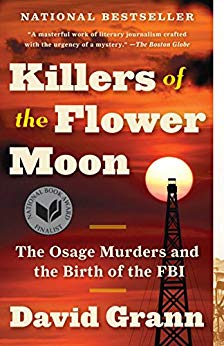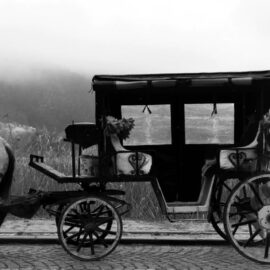

This article is an excerpt from the Shortform summary of "Killers of the Flower Moon" by David Grann. Shortform has the world's best summaries of books you should be reading.
Like this article? Sign up for a free trial here .
Who was Henry Roan? Was his death part of the Osage Reign of Terror?
Henry Roan was an Osage man who had a direct relationship with murder mastermind William Hale. Roan’s death eventually provided clues that helped FBI agent Tom White uncover the conspiracy.
Keep reading to learn about Henry Roan’s tragic end and how it was the start of a horrific episode in Oklahoma’s history.
The Death of Henry Roan
In February 1923, the body of a 40-year-old Osage man named Henry Roan was found slumped behind the steering wheel of a Buick, a few miles outside of Fairfax. Roan had been shot in the back of the head. Local authorities notified William Hale, whom Roan had considered a close friend and benefactor. In fact, Hale was the benefactor of Roan’s $25,000 life insurance policy. Hale was present when another gruesome citizens inquest and autopsy was performed on Roan’s remains. Of course, Hale didn’t reveal the existence of the life insurance policy—which had given him a direct financial interest in Roan’s death.
Henry Roan’s death was shocking to Mollie, who had just given birth to her third child—a girl named Anna. Roan had briefly been Mollie’s husband, back in 1902, before she’d met Ernest. As it was a traditional Osage marriage, there was no legal record of it, but Mollie still had a deep and personal connection to Roan. She had never told Ernest about this marriage, however, and chose to keep her connection to this latest murder a secret.
The murder of Roan created an atmosphere of terror and paranoia that ripped the community apart. People began to suspect their neighbors, friends, and even family of being involved in the deadly conspiracy. Bill Smith, Mollie’s brother-in-law, had been looking into the killings on his own, unable to shake the suspicion that his mother-in-law, Lizzie, had been poisoned.
He and his wife Rita, Mollie’s sister, began to receive threats and intimidating “warnings” as Bill appeared to get closer to the truth, especially after he discovered a connection between Roan’s murder and local criminal kingpin and bootlegger Henry Grammer. It seemed that Henry Roan had told people he was headed to Grammer’s ranch to get some illegal whiskey right before he disappeared—and that Anna Burkhart had often visited Grammer’s ranch as well. Bill and Rita Smith fled their home in early 1923, believing that they were being targeted. Bill confided to his friends that he “didn’t expect to live long.”
The Investigation Into Henry Roan’s Death
White was able to use the information he obtained from Blackie Thompson about Henry Roan to “break” Ernest Burkhart. Ernest was clearly scared and defeated. He finally confessed to Tom White, admitting that Hale had tasked him with recruiting the operatives to blow up the Smith house. Burkhart said that Asa Kirby (recruited through the bootlegger Henry Grammer) had actually made the bomb and ignited the fuse, not Burt Lawson—Lawson, like so many jailhouse informants throughout the case, likely in the hopes of getting his sentence reduced. He also revealed that Hale had traveled with Grammer to Texas on the day of the bombing, with the express purpose of manufacturing an alibi.
Ernest also linked Hale directly to the murder of Henry Roan, stating that a contract killer named John Ramsey (another associate of Grammer) had been hired to kill him. Agents in the field immediately apprehended Ramsey, brought him into custody and presented him with Burkhart’s signed confession. Ramsey, in turn, confessed to getting Roan drunk and shooting him in the back of the head.
The Trial for Henry Roan’s Murder
The national press covered the murders and the ensuing trial with a grisly fascination, often treating it as an entertaining spectacle, rather than as a tragedy defined by the exploitation and grief of a long-suffering and persecuted people. For their part, the Osage simply wanted to see justice done and do everything in their power to ensure that Hale’s powerful influence wouldn’t tamper with the trial.
But this was a tall order. The Oklahoma state judicial system was wracked with corruption, with judges and prosecutors widely known to take bribes from wealthy defendants. A man like William Hale would easily be able to manipulate the system. White understood that his case was dead if he had to take it to state court. His only chance of securing a conviction was to take the case to federal court.
But because most of the surface land allotted to the Osage had already been sold to whites (the Osage retained the oil and minerals underneath), most of these murders had thus taken place on land that was under Oklahoma’s jurisdiction. There was one exception, however: the murder of Henry Roan, whose body had been discovered on Osage-controlled territory, and, theoretically, eligible for federal prosecution. This was the case they decided to bring Hale up on. But here, White and his team suffered another setback when a U.S. district court judge ruled, on technical grounds, that the Roan case had to be tried in state court.
The conviction of Ernest Burkhart, especially in state court, was certainly a victory for White and his team. But the case was far from over. They still needed to put Hale, Bryan Burkhart, and John Ramsey behind bars. But they did receive one bit of good news in this uphill battle: the U.S. Supreme Court had finally ruled that Henry Roan’s murder had been on federal land after all, and thus Hale and his henchmen could be tried in federal court.
On July 29, 1926, Hale was put on trial for aiding and abetting the murder of Henry Roan, while Ramsey was charged with the killing itself. As the trial unfolded, the jury learned that the pair had originally plotted to kill Roan through the slow administration of poisoned moonshine—confirming to the Osage community that many of the slow, wasting deaths of their friends and family (likely including Mollie’s mother, Lizzie, and her other sister, Minnie) had actually been deliberate poisonings.
The investigation into Henry Roan’s death helped lead to other important breaks in the case, and his killers were brought to justice. However, the Osage still mourned Henry Roan, a beloved figure in the community.

———End of Preview———
Like what you just read? Read the rest of the world's best summary of David Grann's "Killers of the Flower Moon" at Shortform .
Here's what you'll find in our full Killers of the Flower Moon summary :
- How the Osage tribe had vast oil wealth, but had it seized by their murderous neighbors
- The brutal and unresolved murders of Osage Native Americans
- The complicated history of the FBI in profiting from the Osage murders






